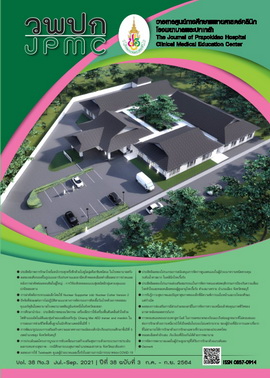Health Perception and Health Problems of Children with Congenital Craniofacial Anomalies
Main Article Content
Abstract
BACKGROUND: Congenital craniofacial anomalies have a significant impact on children and their families. The severity of these deformities depends on the nature of disease and leads to differences in health perception and health problems for pediatric patients.
OBJECTIVES: To explore health perception and health problems in children with congenital craniofacial anomalies.
METHODS: In this descriptive research, purposive sampling was used to recruit 121 children aged 7 - 18 years old with craniofacial anomalies who received healthcare services at the Princess Sirindhorn Craniofacial Center, King Chulalongkorn Memorial Hospital, Thai Red Cross Society from October 2018 to September 2020. Interviewing was used to collect personal information, health perception and health problems. Medical records were used to collect patient history and treatment. Data were analyzed using descriptive statistics.
RESULTS: Children had an overall score between 20 and 63 ( X = 33.3, SD = 9.4) for health perception and health problems. The majority of the children (80.2 %) had low level for health perception and health problems. When considering each aspect, we also found low level of health perception and health problems in all aspects in most children. The physical aspect scored between 5 and 15 ( X = 8.1, SD = 2.4), whereas the psychological and emotional aspect scored between 7 and 23 ( X = 13.0, SD = 4.4). The developmental and learning aspect scored between 4 and 16 ( X = 6.9, SD = 2.9), whereas the daily activities aspect scored between 4 and 14 ( X = 5.33, SD = 2.1). Although children’s perception toward both overall and each aspect of health perception and health problems were low, nearly one - third of the children (31.4 %) perceived a moderate level of psychological and emotional aspect.
CONCLUSIONS: Healthcare personnel should provide additional psychological and emotional support for children with congenital craniofacial anomalies in order to enhance child development, develop strong mental health, increase self - acceptance, instill a sense of pride, and adapt to the society in a better fashion.
Article Details
References
Losee JE, Gimbel ML, Rubin JP, Wallace CG, Wei FC. Plastic and reconstruction surgery. In: FC Brunicardi, Editor. Schwartz’s principles of surgery. Philadelphia: McGraw - Hill; 2015.
Rojvachiranonda N. Different faces...can be changed. Bangkok: Amarin Printing & Publishing; 2018.
Kluba S, Rohleder S, Wolff M, Haas - Lude K, Schuhmann MU, Will BE, Reinert S, Krimmel M. Parental perception of treatment and medical care in children with craniosynostosis. Int J Oral Maxillofac Surg 2016;45:1341 - 6.
Hamilton KV, Ormond KE, Moscarello T, Bruce JS, Merrell SB, Chang KW, et al. Exploring the medical and psychosocial concerns of adolescents and young adults with craniofacial microsomia: a qualitative study. Cleft Palate Craniofac J 2018;55:1430 - 9.
Roberts RM, Shute R. Children's experience of living with a craniofacial condition: perspectives of children and parents. Clin Child Psychol Psychiatry 2011;16:317 - 34.
Crerand CE, Sarwer DB, Kazak AE, Clarke A, Rumsey N Body Image and Quality of Life in adolescents with craniofacial conditions. Cleft Palate Craniofac J 2017;54:2 - 12.
Crerand CE, Rumsey N, Kazak A, Clarke A, Rausch J, Sarwer DB. Sex differences in perceived stigmatization, body image disturbance, and satisfaction with facial appearance and speech among adolescents with craniofacial conditions. Body Image 2020;32:190 - 8.
Volpicelli EJ, Pfaff MJ, Hakimi K, Bradley JP, Solem RC, Lee JC. Age - related differences in psychosocial function of children with craniofacial anomalies. Plast Reconstr Surg 2017; 140:776 - 84.
Speltz ML, Wallace ER, Collett BR, Heike CL, Luquetti DV, Werler MM. Intelligence and academic achievement of adolescents with craniofacial microsomia. Plast Reconstr Surg 2017;140:571 - 80.
Taub PJ, Lampert JA. Pediatric craniofacial surgery: a review for the multidisciplinary team. Cleft Palate Craniofac J 2011;48: 670 - 83.
Leifer G, Fleck E. Growth and development across the lifespan: a health promotion focus. 2nd ed. St.Louisi: Saunders; 2013.
Thato R. Nursing research: concepts to application. 4th ed. Bangkok: Chulalongkorn University; 2018.
Whitaker LA, Pashayan H, Reichman J. A proposed new classification of craniofacial anomalies. Cleft Palate J 1981;18:161 - 76.
Sawasdipanich N, Chaithat B, Dangsomboon A. Healthcare problems and healthcare service accessibility for children with craniofacial anomalies: caregivers’ perception. J Thai Nurs Midwifery Coun 2021;36(2):110 - 28.
Wang JC, Nagy L, Demke JC. Syndromic craniosynostosis. Facial Plast Surg Clin North AM 2016;24:531 - 4.

